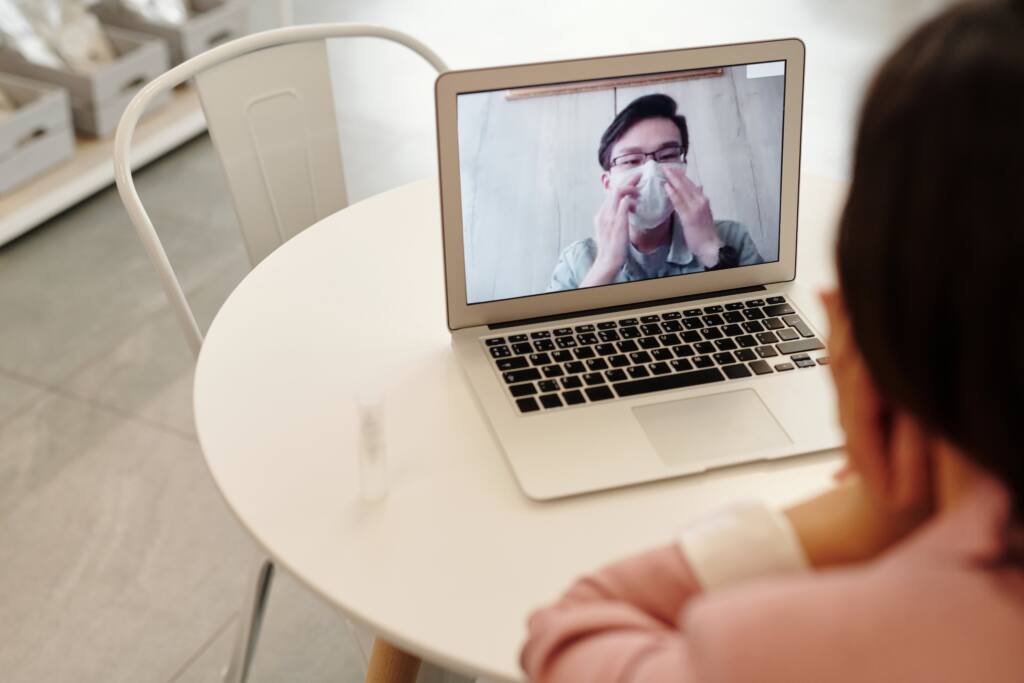What is Telehealth?

Telehealth is a new way to deliver healthcare usPicture by Pexelsing technology. It helps connect patients and healthcare providers without needing to meet in person. This article will explain what Telehealth is, how it works, the benefits it has, and the challenges it faces.
What is Telehealth?
A formal definition of Telehealth:
To truly grasp the concept of Telehealth, it is important to delve into its formal definition. Telehealth is the provision of healthcare services using electronic information and telecommunication technologies, allowing patients and healthcare professionals to connect remotely. It encompasses a broad range of services, including consultations, diagnosis, monitoring, and education.
Moreover, Telehealth differentiates itself from traditional healthcare by removing the limitations of geographical distance and physical presence. Through the use of video conferencing tools and digital platforms, healthcare providers can connect with patients regardless of their location, making it easier to reach individuals living in underserved areas or those with limited mobility.
How does Telehealth work?
The process involves the utilization of various technologies to enable remote healthcare consultations. Typically, a patient requests a virtual appointment with a healthcare professional, and the appointment takes place via video conferencing. For this to work effectively, patients must have a stable internet connection and access to suitable technology, such as a smartphone, tablet, or computer.
During the virtual consultation, healthcare providers can assess the patient’s symptoms, provide medical advice, prescribe medication if necessary, and even refer the patient to in-person care if required. Additionally, through electronic health records and secure messaging systems, patients can seamlessly share test results, medical history, and other relevant information with their healthcare providers.
The simplest definition of Telehealth:
At its core, Telehealth can be defined as a means of receiving healthcare services remotely. In simpler terms, it allows patients to connect with their healthcare providers without the need for physical visits. By utilizing digital platforms and telecommunication technology, healthcare is brought to the patients’ homes, offering convenience and accessibility like never before.
https://7thavewellnessblog.com/?p=3892
Benefits of Telehealth
Telehealth brings numerous benefits both for patients and healthcare providers, revolutionizing the way healthcare is delivered.
Let’s explore some of the key advantages:
Convenience and accessibility for patients: Telehealth eliminates the need for patients to travel long distances or take time off work to visit healthcare facilities. It provides a way to access medical care from the comfort of their own homes, reducing the stress and inconvenience associated with in-person appointments.
Reduction in cost and time for healthcare providers: By utilizing Telehealth, healthcare providers can streamline their operations and reduce overhead costs associated with maintaining physical facilities. Additionally, virtual consultations enable providers to see more patients in a shorter time, optimizing their schedule and increasing efficiency.
Increased access to remote areas and underserved communities: One of the major advantages of Telehealth is its ability to bridge the healthcare gap in remote areas and underserved communities. Individuals who previously had limited access to healthcare due to geographical constraints can now receive quality medical care through virtual consultations.
Types of Telehealth
Telehealth encompasses various modes of remote healthcare delivery.
Let’s take a closer look:
Real-time telemedicine: This form of Telehealth involves live video consultations between patients and healthcare professionals. It allows for real-time interaction and assessment of symptoms, enabling effective diagnosis and treatment recommendations. Real-time telemedicine is particularly useful for urgent care, mental health counseling, and routine check-ups.
Store-and-forward telemedicine: In this model, patient information, including medical records, diagnostic images, and lab results, are securely transmitted from one healthcare provider to another. This asynchronous method enables specialists to review and consult on patient cases without the need for simultaneous communication. Store-and-forward telemedicine is commonly used for second opinions, referrals, and sharing information among healthcare providers.
Remote patient monitoring: The continuous monitoring of a patient’s vital signs and health data from a distance falls under remote patient monitoring. Through wearable devices or home monitoring kits, patients can track their blood pressure, heart rate, blood glucose levels, and other relevant metrics. The data collected is transmitted to healthcare providers for analysis and intervention when necessary. Remote patient monitoring is highly beneficial for individuals with chronic conditions, allowing for proactive management and early intervention.

https://www.ncbi.nlm.nih.gov/
How does Telehealth benefit patients?
Telehealth brings a multitude of benefits to patients, revolutionizing the way they access and engage with healthcare services.
Here are some key advantages:
Improved access to healthcare services: Telehealth removes barriers related to distance, transportation, and limited mobility, providing individuals with greater access to healthcare services. Patients no longer need to postpone or forgo necessary medical care due to geographical constraints.
Enhanced patient engagement and involvement in their own healthcare: Telehealth empowers patients to take an active role in managing their health. With remote consultations, patients have more opportunities to ask questions, discuss treatment options, and actively participate in healthcare decisions.
Better management of chronic diseases through remote monitoring: Individuals with chronic conditions often require regular monitoring and adjustments to their treatments. Telehealth enables these patients to have their vital signs and data continuously tracked remotely, allowing for early detection of potential complications or the need for intervention. This proactive approach to management can significantly improve health outcomes and quality of life.
The benefit to healthcare providers?
Telehealth not only offers advantages for patients but also brings numerous benefits to healthcare providers.
Let’s take a look:
Expanded reach and patient base: By adopting Telehealth, healthcare providers can extend their reach beyond their physical location. They can cater to patients residing in remote areas, expanding their patient base and market reach.
Increased revenue and efficiency in healthcare delivery: Through virtual consultations, healthcare providers can optimize their schedules and see more patients in a given time frame. This increased efficiency translates to improved revenue generation, as more patients can be attended to without the limitations of physical space and time.
Improved patient satisfaction and outcomes: Telehealth provides patients with convenient and accessible care, resulting in higher patient satisfaction levels. Furthermore, with continuous remote monitoring and proactive management of chronic conditions, patients experience better health outcomes and enhanced quality of life.
Regulations and Barriers
While Telehealth holds great promise, some regulatory considerations and barriers need to be addressed for its widespread adoption.
Some of the key challenges include:
Overview of the legal and regulatory considerations for Telehealth: Operate within a legal and regulatory framework that varies from jurisdiction to jurisdiction. Regulations surrounding telecommunication, privacy, reimbursement, and licensure must be thoroughly understood to ensure compliance and seamless implementation.
Challenges and barriers to widespread adoption of Telehealth: Resistance to change, limited access to technology in certain communities, and concerns regarding security and privacy are some of the barriers to the widespread adoption of Telehealth. Addressing these challenges and creating supportive policies and infrastructure are crucial for successful implementation.
Implementing Telehealth in Practice
Healthcare organizations that want to use this technology need to follow specific steps to make the transition smooth.
Some key steps include:
To integrate Telehealth into healthcare organizations, follow these steps:
1. Assess your organization’s needs.
2. Choose a suitable Telehealth platform or provider.
3. Educate and train your staff.
4. Develop protocols and procedures for Telehealth consultations and record-keeping.
Healthcare professionals need training on how to use this technology. They also need to understand the unique considerations of providing remote care. This includes ensuring confidentiality, knowing the limitations of virtual consultations, and developing effective communication skills.
When adopting new technologies in healthcare, it is common to face resistance and address concerns. It is essential to address concerns, provide support and guidance to stakeholders, and emphasize the benefits and opportunities that this technology brings to both patients and healthcare providers.
Technology and Tools

Telehealth relies on various platforms and applications to facilitate remote consultations.
Some notable Telehealth technologies and tools include:
You can find many digital platforms and applications that cater to the needs of patients and healthcare providers. These platforms offer secure video conferencing, messaging, and file-sharing capabilities.
Healthcare providers need to evaluate and choose the best tools for their needs. There are popular platforms like Zoom and Doxy. Me, and VSee, as well as specialized applications for telepsychiatry, mobile health, and remote patient monitoring.
Best practices for successful implementation
To ensure the successful implementation of Telehealth, healthcare organizations must follow best practices.
Some key considerations include:
To protect patient confidentiality and prevent data breaches, it is important to have strong cybersecurity measures in place for telehealth consultations. Healthcare providers must follow privacy regulations and securely store and transmit patient information during these consultations. They should also obtain proper consent and use encryption. Additionally, providing technical support for patients and healthcare providers is crucial. This includes helping them set up telecommunication tools, troubleshooting connectivity issues, and offering guidance on using the platforms. This ensures a positive experience for everyone involved.
Telehealth is changing healthcare. It’s convenient and accessible for patients and healthcare providers. Telehealth uses technology to overcome distance and involve patients. But, using this technology successfully means dealing with laws and regulations, overcoming barriers, and using the best methods. As technology improves, Telehealth will have a bigger impact on healthcare. It will change how patients get healthcare.
FAQ’s
Q: What is telehealth?
A: Telehealth, also known as telemedicine, refers to the use of telecommunications and virtual technology to provide health care services, medical information, and access to care for patients. It allows patients to receive care from their healthcare provider remotely, using various communication technologies.
Q: How does telehealth differ from a virtual visit?
A: While a virtual visit typically involves a specific interaction with a healthcare provider through video conferencing or a virtual platform, telehealth encompasses a broader range of healthcare services and resources that can be accessed remotely, including consultations, monitoring, and management of health conditions.
Q: What are the benefits of utilizing telehealth services?
A: Telehealth offers numerous benefits such as increased access to care, especially for individuals in rural or remote areas, convenience for patients, improved communication between patients and their care team, and the potential for more efficient care delivery.
Q: Can I use telehealth for primary care services?
A: Yes, telehealth can be used for a variety of primary care services, including routine check-ups, follow-up visits, and the management of chronic conditions, providing patients with the ability to connect with their primary care provider without the need for an in-person visit.
Q: Is telehealth covered by Medicare or Medicaid?
A: Yes, both Medicare and Medicaid offer coverage for certain services, enabling beneficiaries to receive care remotely and access options based on their eligibility and specific healthcare needs.







